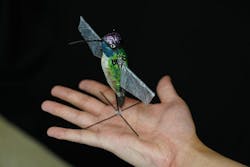Hummingbird-like unmanned flying drone developed at Purdue to push limits of micro technology
The Military & Aerospace Electronics take:
14 May 2019 -- Drones wish they could fly with the agility and grace of the biological family Trochilidae, which includes all 357 types of hummingbirds. Boasting the flying capabilities of birds and the hovering abilities of insects, they represent an intersection of flying philosophies that scientists are eager to unlock.
Hummingbirds could lead to leaps forward for search-and-rescue drones, commercial filming robots, military use, and any other flying venture that is punctuated by quick, unexpected stops and starts.
The Purdue engineers trained their tiny unmanned aerial vehicle (UAV) through an algorithm based on various techniques that hummingbirds from the Andes to America use every day. After going through the training, the robot has an understanding, so to speak, of when to pause and when to take flight. Even more impressive? The robot can't actually see. It senses by touching surfaces, with each touch altering an electrical current.
Related: Engineered by nature: UAV designs modeled after biological sources
Related: Micro-unmanned vehicles invade the military on the ground and in the air
Related: Army asks Norwegian company to design Black Hornet pocket UAV helicopter for foot soldiers
John Keller, chief editor
Military & Aerospace Electronics
Ready to make a purchase? Search the Military & Aerospace Electronics Buyer's Guide for companies, new products, press releases, and videos
